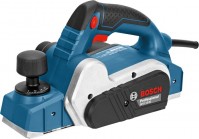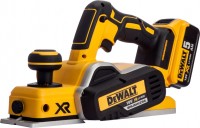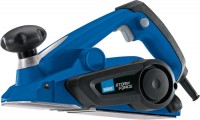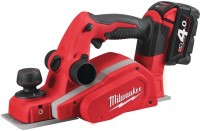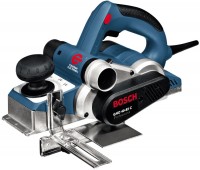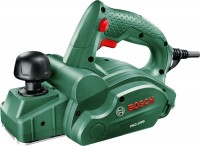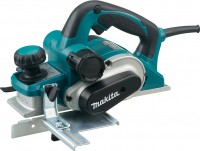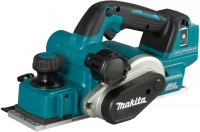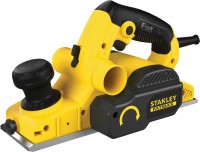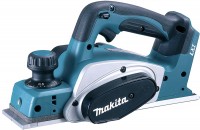Electric Planers Bosch
All Electric Planers Advanced filters → |
You might be interested in
Articles, reviews, useful tips
All materials
Proper storage methods for power tool batteries
Conditions under which batteries will not lose capacity during extended storage

One battery for the whole tool: multi-platform battery series
The concept of using a universal battery for cordless tools is gaining momentum

Which is better: drill, screwdriver or drill-driver?
We study the design features and specifics of the use of such similar, but still different types of power tools
Electric Planers: specifications, types
Power consumption
The total power consumed by the electric planer during operation. The more powerful the tool, the generally higher its productivity and the better it is suitable for large volumes of work and/or hardwoods. Here, however, it must be taken into account that the effective power (the power supplied by the unit directly to the working tool) is anyway lower than the consumed one, but it is far from always indicated. Therefore, it is quite possible to compare different models with each other precisely in terms of power consumption.
Note that more power means higher electricity consumption, and also, most often, more weight and cost of the tool. Therefore, it does not always make sense to chase the most powerful units. So, for occasional use and small volumes of work, a power of 500-600 W is considered quite sufficient; for regular work on relatively soft wood, 700-800 W is enough, and professional models have a power of more than 1000 W.
Note that more power means higher electricity consumption, and also, most often, more weight and cost of the tool. Therefore, it does not always make sense to chase the most powerful units. So, for occasional use and small volumes of work, a power of 500-600 W is considered quite sufficient; for regular work on relatively soft wood, 700-800 W is enough, and professional models have a power of more than 1000 W.
Rotation speed
The maximum speed of rotation of the working tool of the electric planer — a drum with knives attached to it. In modern models, this figure is practically never lower than 10,000 rpm (otherwise it is impossible to ensure normal quality of work), and in most cases it is in the range of 11,000 – 17,000 rpm. It is believed that the higher the number of revolutions, the more evenly the workpiece is processed and the smoother the surface is obtained; and the overall speed of work will be higher. On the other hand, a high speed also requires high engine power, especially when working with hardwoods; for such materials, it makes sense to use a low-speed tool — it will provide more efficient power distribution.
Planing width
The width of the strip that the planer processes in one pass. The larger this width, the fewer passes will be needed for surface treatment and the more convenient it will be to work with large workpieces. In most modern electric planers, this figure varies between 80-100 mm.
Note that a larger width requires a more powerful engine and can significantly affect the cost of the tool.
Note that a larger width requires a more powerful engine and can significantly affect the cost of the tool.
Planing depth
The greatest thickness of the layer of material that the planer can remove in one pass (most often the design provides for depth adjustment). The larger this parameter, the more performant the tool will be and the better it will be suitable for large-scale work. On the other hand, in fact it is rarely necessary to remove a large amount of material at a time, and tools capable of this require powerful (and therefore expensive) motors. Therefore, in most consumer-level models, the planing depth does not exceed 2 mm; more "deeper" units, usually, belong to the professional class.
Grooving depth
The greatest depth of the groove that can be cut into the workpiece with a planer.
Grooves are narrow and long slots used, in particular, for tenoning wooden parts. Some models of electric planers are equipped with special tools that make it easier to cut grooves.
Grooves are narrow and long slots used, in particular, for tenoning wooden parts. Some models of electric planers are equipped with special tools that make it easier to cut grooves.
V-grooves
The number of V-grooves provided in the design of the tool.
V-shaped grooves are located on the sole of the tool in the longitudinal direction. They are used to chamfer the corners of the workpiece, serving as a kind of guide: the tool is “put on” by the groove on the corner being machined and moves along the workpiece so that the corner constantly maintains contact with the groove. It is much easier to keep the planer level with this way of working than with a solid flat sole; this is especially true in cases where the workpiece cannot be turned "angle up" and the planer has to be kept in an inclined position.
Also note that this function is intended only for the first pass along the corner, then you have to work in the classical way, with a flat sole — however, with a sufficient depth of the V-shaped groove, the chamfer can be removed immediately, in the first pass. Actually, this is the point of having several grooves in the design — in such cases they have different depths and can be useful for different chamfer sizes. The maximum number of grooves found in modern electric planers is three ; using more in a hand tool just doesn't make sense.
V-shaped grooves are located on the sole of the tool in the longitudinal direction. They are used to chamfer the corners of the workpiece, serving as a kind of guide: the tool is “put on” by the groove on the corner being machined and moves along the workpiece so that the corner constantly maintains contact with the groove. It is much easier to keep the planer level with this way of working than with a solid flat sole; this is especially true in cases where the workpiece cannot be turned "angle up" and the planer has to be kept in an inclined position.
Also note that this function is intended only for the first pass along the corner, then you have to work in the classical way, with a flat sole — however, with a sufficient depth of the V-shaped groove, the chamfer can be removed immediately, in the first pass. Actually, this is the point of having several grooves in the design — in such cases they have different depths and can be useful for different chamfer sizes. The maximum number of grooves found in modern electric planers is three ; using more in a hand tool just doesn't make sense.
Knives
The design of knives intended for use with a planer and, usually, supplied as standard. The type of knives does not affect the performance of the tool, but in the case of dullness or nicks, the methods for correcting the situation differ significantly.
— Unilateral. As the name suggests, these knives are sharpened on one side only. If defects appear on the blade, it can be removed and sharpened or the edge straightened. Technically, such an operation can be carried out many times, but it requires not only time, but also appropriate skills and equipment.
— Bilateral. Knives sharpened on both sides are very convenient due to the fact that when the edge becomes dull or serrated, it is enough to remove the knife and install it on the other side, with a “fresh” blade. On the other hand, such blades do not allow sharpening — when the second side of the knife becomes unusable, the only option is to replace it.
— Unilateral. As the name suggests, these knives are sharpened on one side only. If defects appear on the blade, it can be removed and sharpened or the edge straightened. Technically, such an operation can be carried out many times, but it requires not only time, but also appropriate skills and equipment.
— Bilateral. Knives sharpened on both sides are very convenient due to the fact that when the edge becomes dull or serrated, it is enough to remove the knife and install it on the other side, with a “fresh” blade. On the other hand, such blades do not allow sharpening — when the second side of the knife becomes unusable, the only option is to replace it.
Dust removal
The direction of waste ejection (dust, shavings, etc.) arising from the operation of the electric planer.
— Unilateral. This category includes models that can throw waste only in one direction, without the possibility of change. Most often, the ejection is done to the right — thus, with a classic right-handed grip, the chips will not fly into the user's face. However, left-handers may have problems — there are very few special models for them. And in difficult jobs where an unusual grip may be needed, the inability to change the direction of the ejection can create serious problems. On the other hand, a “one-sided” instrument is simpler and cheaper than a “two-sided” one, other things being equal.
— Bilateral. Tools from this category have a switch that allows you to choose which direction the chips will be ejected — to the right or to the left. This allows you to optimally set the direction depending on the holding of the planer (right or left hand) and other features of the situation.
— Unilateral. This category includes models that can throw waste only in one direction, without the possibility of change. Most often, the ejection is done to the right — thus, with a classic right-handed grip, the chips will not fly into the user's face. However, left-handers may have problems — there are very few special models for them. And in difficult jobs where an unusual grip may be needed, the inability to change the direction of the ejection can create serious problems. On the other hand, a “one-sided” instrument is simpler and cheaper than a “two-sided” one, other things being equal.
— Bilateral. Tools from this category have a switch that allows you to choose which direction the chips will be ejected — to the right or to the left. This allows you to optimally set the direction depending on the holding of the planer (right or left hand) and other features of the situation.
Features
— Soft start. The presence of a soft start function in the electric planer.
By themselves, the electric motors used in modern planers "start" very abruptly. This leads to jerks of the tool at start-up, due to which it is possible to spoil the workpiece or even drop the unit, which is fraught with injury. In addition, during a normal, non-soft start, the motor consumes a very high current at the moment of start, which leads to voltage surges in the network and an increased load on it. To avoid this, some tools are equipped with a soft start system — an electronic unit that limits starting currents. Due to such electronics, the engine enters the “slowly” mode, without jerks and power surges, which positively affects both the state of the network and the safety of use.
— Maintain momentum. The presence of the function of maintaining speed in the electric planer.
This function is designed to keep the motor speed constant regardless of the load on the blades. Without speed maintenance, this speed decreases as the load on the tool increases and increases when the knives are released. At the same time, the features of the use of planers are such that in “problem” areas (knots, uneven wood, etc.), where the resistance increases, high speed is just needed for high-quality processing, and with low resistance, it is not necessary to keep the speed particularly. Accordingly, the electronics responsible for maintaining...the speed monitors the resistance of the material and automatically regulates the power supplied to the engine: as the load increases, the power also increases, and vice versa. This not only allows you to cope with difficult areas, but also improves the quality of processing in general, reduces wear, and also allows you to use electricity more rationally — the planer "takes" a lot of electricity only when it is really needed.
— Brushless motor. The presence of a brushless (brushless) electric motor in the design of the tool. As the name suggests, this electric motor does not have a brushed commutator used in traditional electric motors. This design is more expensive, but it offers a number of advantages: in particular, brushless motors consume less energy, heat up less, have a lower noise level, and also practically do not spark, which makes it easier to work with a tool in high fire hazard conditions.
— Curved outsole. The presence of a curved sole in the design of the tool. In this case, a sole is meant that is curved in length — in such a way that its front and rear edges are above the middle. Such tools are not suitable for general planing, but they do a good job with some specific jobs. For example, when removing bark from large logs, the curved sole does not cling to knots and other irregularities, and the tool moves freely along the surface to be treated. Actually, the removal of bark from logs is often stated in such tools as the main purpose. However, the matter is not limited to this, the curved sole can also be useful for other tasks — for example, processing concave parts, where a conventional flat planer could not reach the surface. Anyway, curved planers are a rather highly specialized tool, and therefore are extremely rare.
— Quarter sampling. The presence of the function of sampling a quarter in the design of the electric planer. The selection of a quarter can be described as cutting a groove along the edge of the board — thus, instead of a protruding corner, a rectangular recess is obtained. For such work, planers use a special device — a parallel stop: it allows you to move the tool strictly along the edge of the board, ensuring accurate cutting of a quarter groove. If in this model the possibility of sampling a quarter is claimed, this, usually, means that the parallel stop is initially supplied in the kit.
Theoretically, a quarter can be sampled with almost any planer, without a special stop. However, in fact, in order to achieve this more or less tolerable quality, a very high level of skill is required, while even a beginner can cope with such a task with the presence of a parallel fence.
— Folding shoe. The presence of a folding shoe in the design of the tool.
The drop shoe is an additional stand designed to ensure that the planer can be safely placed directly on the sole during non-working hours. The need for such a function is primarily due to the fact that the planer knives, after turning off the engine, continue to rotate by inertia for some time — and this time can be quite significant, on the order of 20 – 30 s. Without a special stand, the planer would either have to be held in hands (which is not very convenient) or laid on its side (which is not always accessible and not very safe — not all tools can lie stably in this position). And if there is a stand, the tool can be placed with the sole down, without fear of spoiling the surface under it: the shoe slightly raises the sole, and the knives rotate in the air without touching the supporting surface.
Such a stand is usually installed in the back of the sole and is made spring-loaded: while the planer is in the air, the shoe is folded down to its working position, and to fold it, you need to lightly press the tool, moving it forward. This minimizes the chance of a planer with unstopped knives resting on the support when the shoe is folded.
— Stationary installation. A planer with the possibility of stationary installation can be turned upside down and secured in this position. When working, accordingly, the user will have to move not the tool over the workpiece, but vice versa — the workpiece over the tool. In other words, the planer in this position actually turns into a compact planer. This format of work is especially convenient if the weight of the workpiece is small, and it is more convenient to hold it in your hands than a massive planer. And if you need to process many small parts at once, a stationary installation can be a real salvation.
Note that the method of fixing can be different: some models are equipped with their own stand, others are fixed on the workbench using a special clamp. The specific installation method for the selected model needs to be specified separately, as well as the presence of the aforementioned stand or clamp in the kit: usually the planer is immediately supplied with everything necessary for stationary placement, but there may be exceptions.
By themselves, the electric motors used in modern planers "start" very abruptly. This leads to jerks of the tool at start-up, due to which it is possible to spoil the workpiece or even drop the unit, which is fraught with injury. In addition, during a normal, non-soft start, the motor consumes a very high current at the moment of start, which leads to voltage surges in the network and an increased load on it. To avoid this, some tools are equipped with a soft start system — an electronic unit that limits starting currents. Due to such electronics, the engine enters the “slowly” mode, without jerks and power surges, which positively affects both the state of the network and the safety of use.
— Maintain momentum. The presence of the function of maintaining speed in the electric planer.
This function is designed to keep the motor speed constant regardless of the load on the blades. Without speed maintenance, this speed decreases as the load on the tool increases and increases when the knives are released. At the same time, the features of the use of planers are such that in “problem” areas (knots, uneven wood, etc.), where the resistance increases, high speed is just needed for high-quality processing, and with low resistance, it is not necessary to keep the speed particularly. Accordingly, the electronics responsible for maintaining...the speed monitors the resistance of the material and automatically regulates the power supplied to the engine: as the load increases, the power also increases, and vice versa. This not only allows you to cope with difficult areas, but also improves the quality of processing in general, reduces wear, and also allows you to use electricity more rationally — the planer "takes" a lot of electricity only when it is really needed.
— Brushless motor. The presence of a brushless (brushless) electric motor in the design of the tool. As the name suggests, this electric motor does not have a brushed commutator used in traditional electric motors. This design is more expensive, but it offers a number of advantages: in particular, brushless motors consume less energy, heat up less, have a lower noise level, and also practically do not spark, which makes it easier to work with a tool in high fire hazard conditions.
— Curved outsole. The presence of a curved sole in the design of the tool. In this case, a sole is meant that is curved in length — in such a way that its front and rear edges are above the middle. Such tools are not suitable for general planing, but they do a good job with some specific jobs. For example, when removing bark from large logs, the curved sole does not cling to knots and other irregularities, and the tool moves freely along the surface to be treated. Actually, the removal of bark from logs is often stated in such tools as the main purpose. However, the matter is not limited to this, the curved sole can also be useful for other tasks — for example, processing concave parts, where a conventional flat planer could not reach the surface. Anyway, curved planers are a rather highly specialized tool, and therefore are extremely rare.
— Quarter sampling. The presence of the function of sampling a quarter in the design of the electric planer. The selection of a quarter can be described as cutting a groove along the edge of the board — thus, instead of a protruding corner, a rectangular recess is obtained. For such work, planers use a special device — a parallel stop: it allows you to move the tool strictly along the edge of the board, ensuring accurate cutting of a quarter groove. If in this model the possibility of sampling a quarter is claimed, this, usually, means that the parallel stop is initially supplied in the kit.
Theoretically, a quarter can be sampled with almost any planer, without a special stop. However, in fact, in order to achieve this more or less tolerable quality, a very high level of skill is required, while even a beginner can cope with such a task with the presence of a parallel fence.
— Folding shoe. The presence of a folding shoe in the design of the tool.
The drop shoe is an additional stand designed to ensure that the planer can be safely placed directly on the sole during non-working hours. The need for such a function is primarily due to the fact that the planer knives, after turning off the engine, continue to rotate by inertia for some time — and this time can be quite significant, on the order of 20 – 30 s. Without a special stand, the planer would either have to be held in hands (which is not very convenient) or laid on its side (which is not always accessible and not very safe — not all tools can lie stably in this position). And if there is a stand, the tool can be placed with the sole down, without fear of spoiling the surface under it: the shoe slightly raises the sole, and the knives rotate in the air without touching the supporting surface.
Such a stand is usually installed in the back of the sole and is made spring-loaded: while the planer is in the air, the shoe is folded down to its working position, and to fold it, you need to lightly press the tool, moving it forward. This minimizes the chance of a planer with unstopped knives resting on the support when the shoe is folded.
— Stationary installation. A planer with the possibility of stationary installation can be turned upside down and secured in this position. When working, accordingly, the user will have to move not the tool over the workpiece, but vice versa — the workpiece over the tool. In other words, the planer in this position actually turns into a compact planer. This format of work is especially convenient if the weight of the workpiece is small, and it is more convenient to hold it in your hands than a massive planer. And if you need to process many small parts at once, a stationary installation can be a real salvation.
Note that the method of fixing can be different: some models are equipped with their own stand, others are fixed on the workbench using a special clamp. The specific installation method for the selected model needs to be specified separately, as well as the presence of the aforementioned stand or clamp in the kit: usually the planer is immediately supplied with everything necessary for stationary placement, but there may be exceptions.
Power source
— Mains. Powered by a conventional 230 V household mains. This option combines reliability, power and virtually unlimited operating time. On the one hand, the tool can be used as long as there is voltage in the network (unless you need to monitor the loads and prevent overheating). On the other hand, there is no battery in the design, which increases the weight and cost. On the third, the characteristics of the 230 V network make it possible to create electric planers of almost any power for it (of course, within the limits that are found in a consumer-level tool). However, there are drawbacks, and the most striking of them is poor battery life: to power the tool, the actual presence of sockets is required, and the power cord significantly limits mobility, and it also tends to get underfoot.
— Battery. Powered by its own built-in battery, it is remarkable, first of all, for a high degree of battery life: the tool is not connected to sockets and can be used even where there is no network at all. And the cord does not interfere with work. At the same time, the battery significantly increases the weight and cost of the tool compared to similar "mains" models, and the battery life is somehow limited — and when the charge is exhausted, you still have to look for an external power source. However, the main disadvantage of rechargeable electric planers is their low power: the fact is that powerful motors...require batteries that are so heavy and expensive that such a design would simply be meaningless. Therefore, it is worth choosing models with such a power supply only if battery life plays a decisive role for you, and high power is not required.
— Battery. Powered by its own built-in battery, it is remarkable, first of all, for a high degree of battery life: the tool is not connected to sockets and can be used even where there is no network at all. And the cord does not interfere with work. At the same time, the battery significantly increases the weight and cost of the tool compared to similar "mains" models, and the battery life is somehow limited — and when the charge is exhausted, you still have to look for an external power source. However, the main disadvantage of rechargeable electric planers is their low power: the fact is that powerful motors...require batteries that are so heavy and expensive that such a design would simply be meaningless. Therefore, it is worth choosing models with such a power supply only if battery life plays a decisive role for you, and high power is not required.
Batteries in set
- Absent. There is no batteries included in the package - you need to look for them separately. This is associated with certain hassles, but also provides important advantages. Firstly, the model and number of batteries purchased can be chosen at your discretion, depending on your needs and budget. Secondly, there may already be a suitable battery “on the farm” - especially considering that some manufacturers produce universal batteries suitable for different types of power tools of the same brand. Thanks to all this, this option is extremely popular.
— 2 batteries. The most popular option among models supplied with batteries included. In such models, the second battery plays the role of a spare; its presence allows you to extend battery life and minimize charging interruptions: while one battery is in use, the second can be charged.
— 1 battery. Such kits are not particularly common: they are mainly entry-level tools, designed for small amounts of work, when breaks for charging are quite acceptable.
— 2 batteries. The most popular option among models supplied with batteries included. In such models, the second battery plays the role of a spare; its presence allows you to extend battery life and minimize charging interruptions: while one battery is in use, the second can be charged.
— 1 battery. Such kits are not particularly common: they are mainly entry-level tools, designed for small amounts of work, when breaks for charging are quite acceptable.
Battery platform
The name of the battery platform supported by the device. A single battery platform is used to combine various power tools of the same brand into one line (screwdriver, grinder, circular saw, etc.). Devices on the same platform use interchangeable batteries and chargers. Thanks to this, for example, there is no need to select a battery for each individual model of a power tool, because one purchased as a spare battery can be used in various power tools, depending on the situation or as needed. Batteries of the same platform basically differ from each other except perhaps in capacity.
Battery voltage
The voltage of the standard battery of the battery-powered electric planer (see above). Usually, a more powerful tool is equipped with batteries of higher voltage, but performance and other practical characteristics depend not only on this — they are largely determined by the design features of the tool itself.
Battery type
The type of battery installed in the planer (when powered by battery, see above for details). These types are the most popular today.
— Ni-Cd (nickel-cadmium). An obsolete but still used type of rechargeable battery. In the case of electric planers, their main advantages are good capacity combined with a relatively low charging time, reliability, resistance to temperature changes and low cost. However, this type of battery has a very pronounced so-called "memory effect": when charging a battery before it is completely discharged, its capacity decreases. Also, the content itself is considered dangerous from an environmental point of view. As a result, Ni-Cd batteries are gradually giving way to more advanced types.
— Ni-Mh (nickel-metal hydride). The name of these batteries is not without reason similar to nickel-cadmium — they appeared as a development of this technology, aimed at eliminating the main drawbacks. Ni-Mh batteries are also reliable, capacious, resistant to temperature fluctuations — while they are more environmentally friendly and practically devoid of the "memory effect". Among the shortcomings, a slightly shorter service life and the need to comply with specific storage rules can be noted.
— Li-Ion (lithium-ion). The main advantage of this technology is a good weight-to-capacity ratio, which makes it possible to create relatively light batteries with a long operating time. At the same time, the charging time is rather short, and t...he “memory effect” is practically absent. On the other hand, such batteries do not tolerate low temperatures well, and they are quite expensive.
— Ni-Cd (nickel-cadmium). An obsolete but still used type of rechargeable battery. In the case of electric planers, their main advantages are good capacity combined with a relatively low charging time, reliability, resistance to temperature changes and low cost. However, this type of battery has a very pronounced so-called "memory effect": when charging a battery before it is completely discharged, its capacity decreases. Also, the content itself is considered dangerous from an environmental point of view. As a result, Ni-Cd batteries are gradually giving way to more advanced types.
— Ni-Mh (nickel-metal hydride). The name of these batteries is not without reason similar to nickel-cadmium — they appeared as a development of this technology, aimed at eliminating the main drawbacks. Ni-Mh batteries are also reliable, capacious, resistant to temperature fluctuations — while they are more environmentally friendly and practically devoid of the "memory effect". Among the shortcomings, a slightly shorter service life and the need to comply with specific storage rules can be noted.
— Li-Ion (lithium-ion). The main advantage of this technology is a good weight-to-capacity ratio, which makes it possible to create relatively light batteries with a long operating time. At the same time, the charging time is rather short, and t...he “memory effect” is practically absent. On the other hand, such batteries do not tolerate low temperatures well, and they are quite expensive.
Battery capacity
The capacity of the complete battery of the electric planer (in the corresponding models, see "Power"). This indicator determines how much energy the battery can store. It is measured in ampere-hours: 1 Ah is the capacity at which the battery can deliver a current of 1 A for 1 hour.
The higher the capacity of the battery, the longer the battery life of the tool, usually. However, keep in mind that this time also depends on many other factors. For example, a more powerful tool model will require more electricity and drain the battery faster. And the same planer at light loads will work significantly longer than with hardwood and/or a large depth of planing.
The higher the capacity of the battery, the longer the battery life of the tool, usually. However, keep in mind that this time also depends on many other factors. For example, a more powerful tool model will require more electricity and drain the battery faster. And the same planer at light loads will work significantly longer than with hardwood and/or a large depth of planing.
Battery type
The model of a standard battery allows you to find out its characteristics in more detail, and also helps you understand what devices it is like and which one should be purchased in case of a replacement due to a malfunction or, if necessary, buy another similar one.
Compatible batteries
Battery models that the saw of the corresponding type is compatible with (see “Power source”). This information will be useful in cases where the battery(ies) must be purchased separately, for example, if the tool does not come with a battery at all, if you need to supplement the original package, or if the existing battery has failed.
Charging time
The time required to fully (from zero to 100%) charge the battery in a rechargeable electric planer (see "Power Source"); this refers to the complete battery and standard charger. The shorter this time, the shorter the breaks will have to be done for recharging; however, larger batteries inevitably take longer to charge than smaller ones. This can be compensated by the use of fast charging technologies, but they, in turn, affect the cost of the tool.
Charge level indicator
The presence of an indicator in the tool that displays the current battery level. The design and functionality of such an indicator may be different, often the simplest LED indicators are used, allowing only an approximate estimate of the remaining energy. Also note that the charge level indicator may not be placed on the body of the tool, but on the battery itself. Nevertheless, this feature anyway provides additional convenience, makes it easier to monitor the state of the battery and reduces the risk of being left with a “dead” battery at the wrong time.
Battery mount
The battery mount type determines how the battery pack is secured to the power tool.
- Clip. The battery pack in the form of a clip is inserted into the body of the power tool, namely into the handle, from which the name actually comes. Note that this type of mount is suitable for batteries of small capacities, because it is often not possible to hide powerful capacitive elements in the handle body.
— Slider. The slider involves fixing the battery pack on the surface of the body of the power tool. This type of mount is represented by a slide on which the battery slides. The advantage of the slider is the ability to use more battery cells, which in turn increases the capacity. Of the shortcomings, it can only be noted that the increase in the dimensions of the power tool when the battery is connected.
- Clip. The battery pack in the form of a clip is inserted into the body of the power tool, namely into the handle, from which the name actually comes. Note that this type of mount is suitable for batteries of small capacities, because it is often not possible to hide powerful capacitive elements in the handle body.
— Slider. The slider involves fixing the battery pack on the surface of the body of the power tool. This type of mount is represented by a slide on which the battery slides. The advantage of the slider is the ability to use more battery cells, which in turn increases the capacity. Of the shortcomings, it can only be noted that the increase in the dimensions of the power tool when the battery is connected.
In box
— Dust collector. The presence of a dust collector in the delivery set — a special bag for collecting dust, chips and other waste that occurs during operation. This bag connects directly to the waste chute, so that the waste stays in the dust bin and cleaning up after work becomes much easier. However the dimensions of the tool with the bag attached increase somewhat, and during work it is necessary to monitor its filling and release it in time — otherwise the accumulated chips can jam or even break the planer.
— Case (bag). The presence in the delivery set of a special case — a suitcase for storing and carrying a tool, which also provides some degree of protection. Using a case for such purposes is much more convenient than various "non-native" packages: it is optimally adapted to a specific planer model, in addition, it often has specialized compartments for additional accessories. There are also rag bags, lighter, but at the same time less protective.
— Case (bag). The presence in the delivery set of a special case — a suitcase for storing and carrying a tool, which also provides some degree of protection. Using a case for such purposes is much more convenient than various "non-native" packages: it is optimally adapted to a specific planer model, in addition, it often has specialized compartments for additional accessories. There are also rag bags, lighter, but at the same time less protective.
Noise level
The maximum noise level produced by the planer during operation. The lower this indicator, the more comfortable the use of the tool, the less inconvenience it creates for both the user and others. Note that the noise level is measured in decibels, and this is not a linear unit — in other words, sounds with a difference of several dB in volume can differ significantly. A few examples for comparison: 75 dB noise is approximately equivalent to a scream, 80 dB is a motorcycle engine, 85 dB is a loud scream, 90 dB is the sound of a freight car moving at a distance of 5-6 m, 95 dB is the noise inside a subway car.
Power cord length
The length of the network cable can tell you how far from the outlet you can operate the device. Therefore, for domestic use, it is more relevant to choose models with a short cord, for construction work or use in production, in the garage a longer cable is better.


